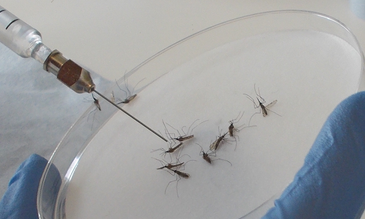
Topical testing assays are used for screening active ingredients by directly depositing actives in solution onto the dorsal thorax of adult mosquitoes, to assess the mortality of adult mosquitoes to insecticide when applied directly as a droplet.
The precise concentration of active ingredient is known and exposure to the insecticide is more accurate than other bioassays. This method also reduces the effect of avoidance or grooming behaviour by the mosquito.
Results are presented as requested by the client including diagnostic curves used to determine diagnostic dose.
Overview of any published methods and related publications
Many papers have used topical testing on a range of different insect species such as house flies (Skelton & Hunter., 1970), fleas (Moyses & Gfeller., 2001), moths (Abernathy et al.,1996), and mosquitoes (Julia et al., 2009).
T. E. Skelton, P. E. Hunter, Flight and Respiration Responses in House Flies following Topical Application of Sterilization Levels of Tepa,, Annals of the Entomological Society of America, Volume 63, Issue 3, 15 May 1970, Pages 770–773, https://doi.org/10.1093/aesa/63.3.770
Moyses, E.W. and Gfeller, F.J., 2001. Topical application as a method for comparing the effectiveness of insecticides against cat flea (Siphonaptera: Pulicidae). Journal of medical entomology, 38(2), pp.193-196.
Abernathy, R.L., Teal, P.E., Meredith, J.A. and Nachman, R.J., 1996. Induction of pheromone production in a moth by topical application of a pseudopeptide mimic of a pheromonotropic neuropeptide. Proceedings of the National Academy of Sciences, 93(22), pp.12621-12625.
Julia W. Pridgeon, James J. Becnel, Gary G. Clark, Kenneth J. Linthicum, A High-Throughput Screening Method to Identify Potential Pesticides for Mosquito Control, Journal of Medical Entomology, Volume 46, Issue 2, 1 March 2009, Pages 335–341, https://doi.org/10.1603/033.046.0219
